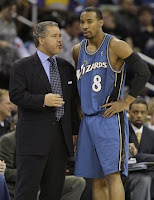 In D.C., injuries have forced younger players to step up quickly.
In D.C., injuries have forced younger players to step up quickly.According to coach Ed Tapscott, young players typically " have two or three years to watch, observe and work their way into the rotation - rather than learning through such a heavy dose of trial and error."
"It becomes an object lesson in learning how to play the right way, how to play winning basketball - even when you're not a winning team," Coach Tapscott said. "And there is a right way to play, even when you're not winning, and that's what I kept stressing throughout the game. And we had episodes of good, solid basketball - winning basketball - when you play the right way, and then we have episodes of very poor basketball."
According to this article, Coach Tapscott "has stressed the importance of driving to the basket to generate higher-percentage scoring opportunities. He also wants his guards... to penetrate and draw defenders toward them and then kick the ball out to teammates. But while the Wizards got the ball into the paint, they got caught up in what Tapscott calls hero play, otherwise known as one-on-one basketball."
"Hero basketball is jackknife dunks, reverse layups, plays that make the late-night highlights on sports programming - but they become low-percentage plays," Coach Tapscott explained. "You might make only three or four; what happens on the other six? They're dunks the other way. Great effort, bad percentage basketball. I remember having the same conversations with an old coach a long time ago," Coach Tapscott said with a chuckle, shaking his head. "You get it sooner, or you don't and someone else gets your minutes."



